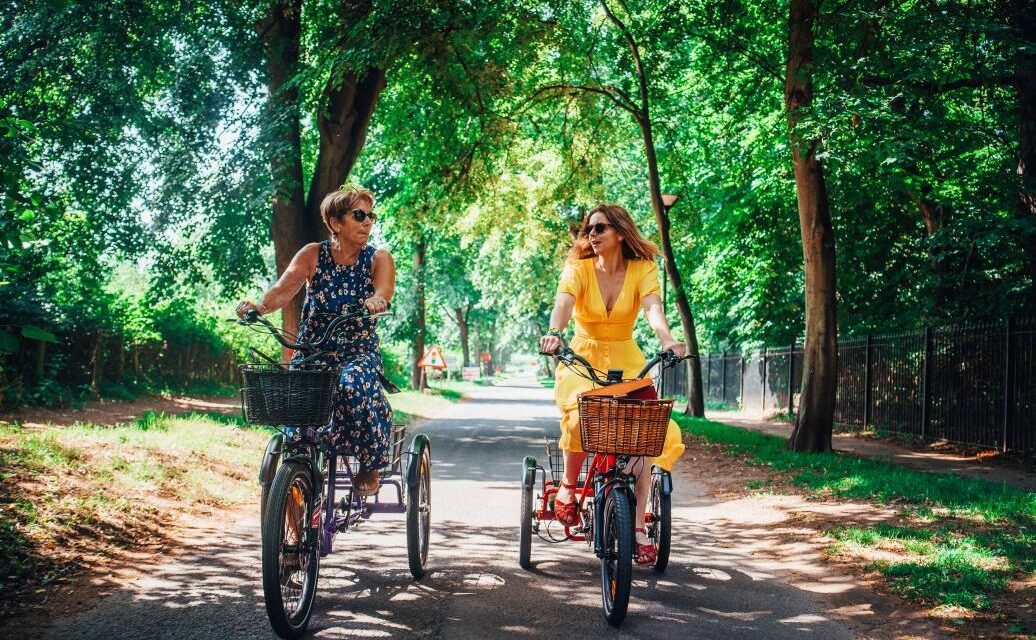The main image is courtesy of Jorvik Tricycles of York.
When we were first made aware of the term “Assistive Technology” we assumed that it referred to helping the elderly reach items on higher shelving, using walking strollers to prevent falls, or some other safety measures, such as placing grab bars in bathrooms.
Little did we know that there is a wide range of assistive technologies for all stages and challenges of life that are currently being utilized every day to address a vast range of circumstances.
Application areas include everything from limiting disabilities (visual, hearing, mobility and cognitive) to early developmental learning, accessible computing, aging-in-place, and physical rehabilitation.
In this article we explore Assistive Technology specifically in the scope of residential living. As our examples demonstrate, there are many products that can transform and elevate your home in terms of safety, usability, comfort and convenience.
We highly recommend resisting any stigma you may feel around being an “early adopter” of Assistive Technology. Proactive awareness and adoption of these solutions can improve your overall wellness, safety and longevity.
We especially recommend viewing our collection of assistive tools that every household should have as a starting point. In fact, with the proliferation of voice-activated technology (e.g. Amazon Alexa and Google Home & Assistant), millions of consumers have already become proficient in using “assistive technology”, perhaps without realizing it.
Regardless, the future will continue to bring about a continuous flow of innovative cross-pollination of technologies, applications areas, and specific use cases, such that all helpful technology should be classified as “assistive”.
Table of Contents
- What is Assistive Technology?
- Types of Assistive Technology for the Home
- Innovative Examples of Assistive Technology for the Home
- Assistive Technology Resources
- Recommended Reading
Also see:
What is Assistive Technology?
According to the ATIA (Assistive Technology Industry Association), Assistive Technology (AT) is broadly defined as:
Any item, piece of equipment, software program, or product system that is used to increase, maintain, or improve the functional capabilities of persons with disabilities
Their definition includes items that can be classified as low-tech to high-tech and everything in-between. The ATIA further expounds that:
Assistive technology helps people who have difficulty speaking, typing, writing, remembering, pointing, seeing, hearing, learning, walking, and many other things. Different disabilities require different assistive technologies.
The State of Minnesota also adds this context to the definition on their Assistive Technology resource site:
Assistive technology (AT) helps people of all ages with disabilities, including older adults with functional needs, increase, maintain, and improve independence at home, school, work, and in their communities.
For the sake of this article, we expand the standard primary focus on disabilities to include a broader, secondary audience that likely are unaware of how these solutions could help them in many everyday situations and life stages.
We envision that proactive awareness of these solutions will help prevent a wide range of residential mishaps and improve situations of varying physical setbacks, be they temporary or terminal situations.
As a growing population of homeowners opt to age in place, many of these solutions will become vital features and aspects of their homes. We especially admire products that not only “assist” users, but contribute to their overall wellness and independence.
We are also optimistic that the benefits of these products will gradually be adopted by users of all ages, consisting of persons with far ranging physical dispositions, even the very healthy and fully able.
Types of Assistive Technology for the Home
The State of Minnesota has a comprehensive Guide to Assistive Technology that includes many types of AT solutions and applications. They categorize these solutions into the following application areas:
- Vision
- Hearing
- Speech Communication
- Learning, Cognition, and Developmental
- Mobility, Seating, and Positioning
- Daily Living
- Environmental Adaptations
- Vehicle Modification and Transportation
- Computers and Related Peripherals
- Recreation, Sports, and Leisure
As all of these application areas relate to residential living, we recommend homeowners simplify these categories into the following groups, as a way to assess their assistive technology needs more easily:
- Home Modifications (AKA Environmental Adaptations)
- Daily In-Home Living Activities
- Mobility Needs
- Visual Assistance
- Hearing Assistance
Innovative Examples of Assistive Technology for the Home
Whether it is a sudden onset physical limitation or a chronic issue that is becoming progressively more impeding, no deficiency should prohibit your living an independent unassisted life in the comfort of your own home.
We have researched a number of sites to discover innovative Assistive Technology Products that address a wide range of needs for independent home living. Presented are a few representative examples of products that can effectively aid various physical impairments.
Examples of Innovative Assistive Technology by Product Category
- Mobility Assistance
- Sleep Inducers
- Visual Impairment
- Audio Impairment
- Physical Impairment
- “Around-the-House” Assistive Tools
Mobility Assistance
Homes that are originally built or modified with “universal mobility” in mind are expected to grow in coming years, driven largely by a growing population of aging-in-place homeowners.
To re-emphasize the proactive theme of this article, we strongly recommend that homeowners, without mobility needs, proactively strive to keep their homes safe for mobility. The area of mobility safety to focus on first is the stairs, specifically preventing falls.
AssiStep cited the following stair-related statistics on their business development website:
- Each year there are more than 1 million injuries occurring on stairs in the US, according to a study in the American Journal of Emergency Medicine
- About 50% of US homes contain stairs, according to the US Census Bureau
- The associated costs of non-fatal stair-related injuries in the US amount to approximately $92 billion per year
Examples of Innovative Mobility Assistive Technology Products
- The Stair Walker AssiStep: A Stair Lift Alternative
- CAN GO Smart Cane
- E-Bikes and E-Trikes for Rehabilitation & Safe Outdoor Mobility
- PriestmanGoode: Scooter for Life
The Stair Walker AssiStep: A Stair Lift Alternative
When mobility issues occur suddenly, and climbing stairs in your home is necessary, the Walker AssiStep is an affordable and safe solution to allow you to use your staircase in in your home. The smart upright design insures you have a firm grip in front of you when walking either up or down the stairs.
The added advantage of the AssiStep is that users of this assistive solution are able to remain physically active by still using the stairs under their own control.
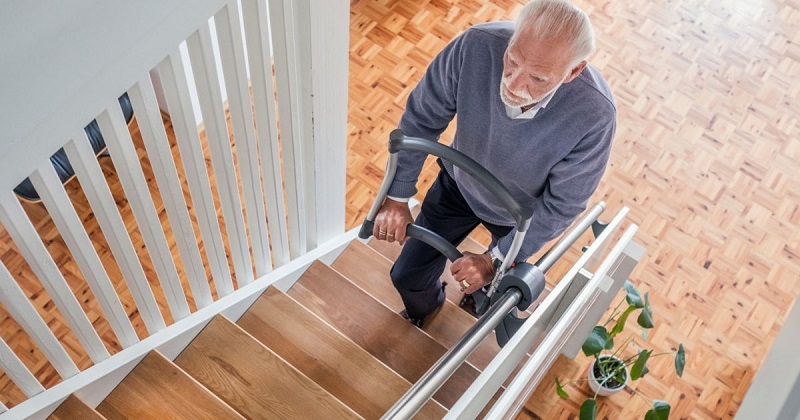
Photo courtesy of AssiStep.
The mission of Assitech, the maker of AssiStep, is to make new and revolutionary walking aids to enable more people to live at home for as long as they desire. Here are a few statements from their website that underscore this commitment:
- Being able to move freely, safely and actively in your own home is what we’re passionate about.
- Living in our own home throughout life is what most of us want … we develop new and innovative solutions to enable this.
- Assistive technology is … supposed to enable you to maintain your functioning and not remove important sources of daily activity.
Though Assistech is currently unavailable in the United States, it is, however, available to purchase in Canada. To learn of when their product will be available in the US, the company recommends signing up to their newsletter.
Hands on with the Stair Walker AssiStep
CAN GO Smart Cane
Designed by a grandson for his grandmother, the CAN GO Smart Cane was developed to help seniors live a safe, independent and mobile lifestyle. After interviewing thousands of users, CAN GO confirmed three key needs on which to focus their innovation:
- Safety and Fall Prevention
- Chronic Health Conditions
- Rehab and Recovery
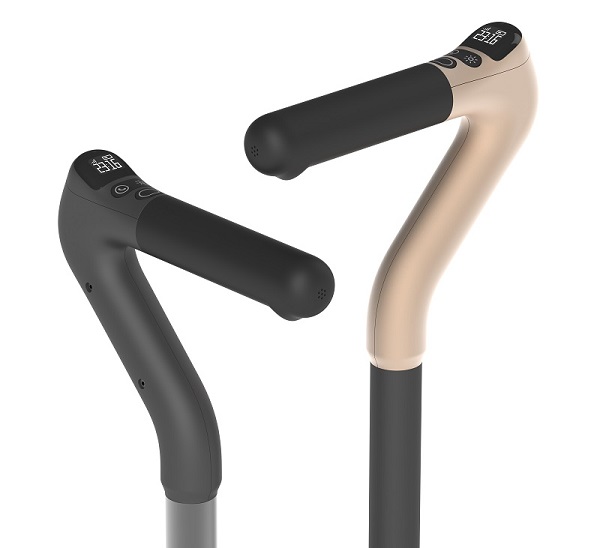
CAN Go Smart Cane Handles
Using Artificial Intelligence (AI), the CAN GO smart cane has a built-in smart phone for emergencies. Equipped with high quality speakers, embedded microphone and 4G technology, the cane allows users to make calls reliably with just the press of a button. With an LED light for evening walks, activity tracking and goal setting and GPS tracking, all housed in a modern ergonomic design, the CAN GO is the tool for healthy activity for the elderly.
Devices with GPS tracking and emergency communication capabilities are especially vital for persons living with dementia. The Alzheimer’s Association states that 6 out 10 of those afflicted with dementia will wander at least once, with many prone to getting lost repeatedly.
CAN Go is currently accepting early-bird reservations.
Also see:
- Walking Canes: How to Choose the Best One for You
- 10 Technological Innovations for Caregivers & Those Living With Dementia
E-Bikes and E-Trikes for Rehabilitation & Safe Outdoor Mobility
There is an emerging market of electric bicycle providers that are creating products focused on both the rehabilitation market, as well as the aging senior market. The wide-ranging features available in many models are all, to varying degrees, aiming to address these key needs:
- Mobility
- Safety
- Balance Issues
- Physical Activity
- Enhanced Utility
- Overall Wellness
Rehabilitative bicycles and tricycles are designed to empower people to maintain their active lifestyles regardless of their health or medical conditions.
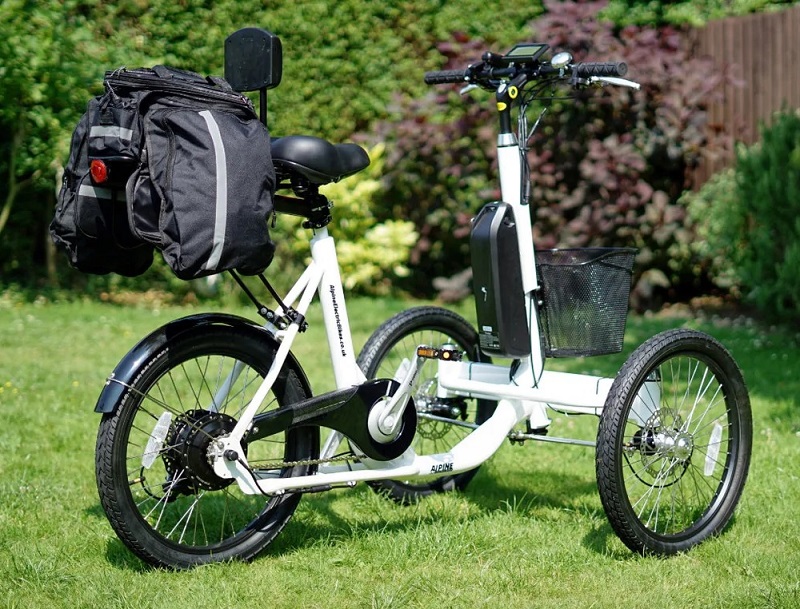
Photo courtesy of Alpine Electric Bikes.
Safe bicycles and tricycles not only enable users to get vital physical activity, but they also invigorate the mind, as riding requires making continuous real-time decisions and spatial judgements. This type of mental exercise serves as vital rehabilitation for stroke victims, for example.
Liberty Trike | Product Overview
Many rehabilitative cycles are equipped with electric motors (e-cycles), with pedal assist systems, which can make the vehicle usable for various energy levels and abilities. These model types also tend to have a low center of gravity and a low step-over threshold to make mounting and dismounting manageable.
Additional features of safe bicycles include: open step-through frames; disc brakes; big tires; added suspension; and large comfortable seating with a relaxed riding position. Storage areas are also a popular feature, as they enable riders to use their cycles for a wider range of activities including recurring errands.
Jorvik Electric Tricycles
Although many of these cycles were designed with certain medical conditions in mind, such as multiple sclerosis, brain injuries and spinal injuries, they are ideal for those looking to remain active even with limited mobility. These innovative products are also being adopted by former avid cyclists who are adapting to diminishing physical capabilities, while still remaining active and benefiting from being outdoors.
Leading brands and resellers who provide rehabilitative and senior-focused electric bicycles and tricycles include:
- Alpine Electric Bikes
- Electric Bike Paradise
- Electricity Cycles
- ElectricTrike
- Emojo
- Heybike
- Himiway
- Jorvik Tricycles
- Liberty Trike
- Pedego Electric Bikes
- Propel Electric Bikes
- Van Raam
Also see:
PriestmanGoode: Scooter for Life
The PriestmanGoode Scooter was created as a prototype and exhibit for the Design Museum in London in 2017. The scooter was designed for elderly adults with the concept that they remain active and independent longer throughout the day, without increasing fatigue.
The design incorporates all elements to ensure comfort, portability, style and practicality. The prototype looks similar to an inspired piece of roller luggage, equipped with a handle, two sturdy wheels, and optional seating and electric power with integrated safety brakes.
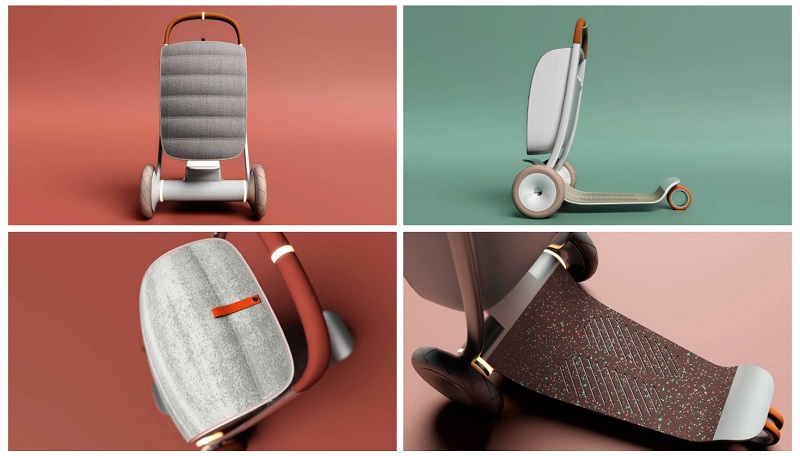
Photo courtesy of PriestmanGoode.
The resulting product is actually designed for all ages throughout life, as it can function as a micro-scooter with an extra wheel for stability. The designers recognized that the PriestmanGoode Scooter should be a product that evolves with your life and lifestyle at any age with the main concept of facilitating intergenerational interaction.
At the present time, we do not know what the commercial plans are for turning the scooter into a scalable product. We do know that it was well received upon its launch, as it symbolizes great potential for empowering persons with limited mobility through thoughtfully and tastefully designed solutions.
Sleep Inducers
Calming Lia: Sleep Inducing Games
Calming Lia is a free game designed by Mingle Games to help induce better quality sleep in its players. The iOS version is designed to be played at night, as it requires the player to utilize the iOS Night Shift mode to solve a series of challenging puzzles.
Players help Calming Lia, the game’s protagonist, who lives in a dreamland and ventures on a number of quests before bedtime, along with her traveling companion, Bao the Bear. The soothing music together with sleep-friendly animation colors combine with the Night Mode feature to create a calming, soporific effect for the user.
Nuvi: Wearable Mask for Sleep
Designed and developed by Auston Health, Co., Ltd, the Nuvi Smart Sleep Mask uses Bluetooth technology to create the perfect slumber conditions for your brain. The mask features LED lights and speakers that work in concert to create a sleep-inducing environment. Users can choose from six different programs to indulge in a Power Nap, or restore and refresh with Jet Lag Adjust. The mask also features a smart alarm to help awaken users naturally, to the tune of gentle music with blue lights.
Also see:
Visual Impairment
Microsoft Seeing AI Narrative Visual Impairment App
Connected to a smartphone, the Seeing AI (Artificial Intelligence) app assists those with visual impairments navigate their surroundings by becoming a “talking camera”. The app has the ability to read and interpret the surroundings of the user by scanning the area and translating the “visual” into words by describing what is being “seen”. Listed features include:
- Reading documents
- Detecting which monetary bills the user has in hand
- Reading bar codes to interpret product descriptions
Eventually the AI capabilities will have the ability to learn from frequency of interactions and allow users to read expressions of individuals of frequently seen people.
Object Detecting Canes
mySmartCane
With an array of sensors to help guide users around obstacles in their surroundings, the mySmartCane walking stick works in a similar manner to Park Assist, the automobile parking feature in most modern cars.
Visually impaired individuals can have the 3D-printed ball, loaded with sensors, retrofitted onto virtually any cane, to provide auditory feedback. The systems plays a series of beeps, which change in frequency, depending on the closeness of the object to the cane, which guide the ocular impaired through their surroundings.
mySmartCane: Giving Freedom to Visually Impaired People
WeWALK Smart Cane
Another product for the visually impaired is the WeWALK Smart Cane handle which attaches to any existing long cane, and vibrates in the presence of low hanging obstacles. When connected to iOS or Android devices via Bluetooth, the device has several smart features that include:
- Accessible Navigation: Obtain turn-by-turn navigation, destination tracking, and low-vision mapping
- Public Transportation: Access public transport stops, timetables, and stop tracking
- What’s Around Me?: Explore nearby places and discover new places
- Track Your Activity: Monitor step count, distance and other cane usage behavior
- Multi-Language Support
Smart Cane Gives the Blind Freedom to Explore
Also see:
Audio Impairment
Neosensory Clarify
Developed by neuroscientists, the Neosensory Clarify Wristband improves auditory impairment without the use of a hearing aid. Neosensory products feed information to the brain via touch with haptic or vibratory motors, cutting-edge algorithms and high computational capacity. The science behind the company’s products is known as “sensory substitution devices“, which reawaken other senses via non-invasive hearing technology.
Introduction to Neosensory Buzz
Physical Impairment
Oneware Cookware
The Oneware series of cookware modular units is the ideal solution for tackling kitchen tasks for an injured hand, unilateral arthritis, amputees, or anyone who has lost the ability of one hand.
Designed and developed by a Singaporean Industrial Design student, the products endeavor to bring full functionality to those with one functional hand, in specially designed food preparation products. Currently the series of one-hand-only kitchenware consists of two pieces: the cutting board and the dish washer.
Where Are They Now: Oneware, 2016 Singapore Winner
Also see:
Voice-Controlled Curtain Systems
When temporary or permanent physical disabilities inhibit simple tasks, such as closing the curtains or blinds, there is an app for that. The Quoya Smart Electric Blind System is a voice-controlled device that can be scheduled to raise or lower curtains and blinds at certain times of day or on demand.
The system uses an automated device that loops drape pulleys through torque-controlled gear. The gear can be activated via Amazon Alexa, Google Home and other voice control devices.
QUOYA MC08 Smart Electric Blinds Motor
“Around-the-House” Assistive Tools
The intent of this article is to encourage households to adopt assistive technology proactively, as many of these types of tools can help prevent accidents, as we age and go through various health setbacks that may limit our mobility, balance, sight, hearing, or other physical capabilities.
Here are a few highly effective “assistive” tools that we believe every household should have. Besides making life more convenient, these types of tools can also prevent taking unnecessary risks when pushing the boundaries of one’s physical capabilities.
- Cobweb Duster Extender
- Flashlight
- Ladder
- Magnifying Glass
- Portable Megaphone Speaker
- Reacher Grabber Tool
- Step Stool
How to Choose a Ladder (4 Steps)
Assistive Technology Resources
- ATIA: Assistive Technology Industry Association
- State of Minnesota’s Guide to Assistive Technology
- State of Minnesota’s Assistive Technology for Home and Community
- Move United: Community Adaptive Sports Programs
- Technology for Home: Technical Assistance for Individuals with Disabilities
- RehabMart
- 10 Technological Innovations for Caregivers & Those Living With Dementia
- The Risks of Wandering
- The Future of Elder Care is Service Robots
- Assistive Technology for Seniors Aging in Place
Recommended Reading
- Need an Aging In Place Specialist? Look for These Certifications!
- Aging In Place Technology for Today and Tomorrow
- Never Thought You’d Live in a Multigenerational Home? Think Again!
- How to Create an Allergy-Free Environment in Your Home
- UV-C Products to Make Your Home Healthier & Virus Free
- Products to Turn Your Bathroom into a Health & Wellness Spa
- Why Homeowners Should Invest in a Prefab ADU
- Does an ADU Add Value to Your Home? Surprising Trends from HomeLight
| Purgula is reader-supported. When you click on links to other sites from our website, we may earn affiliate commissions, at no cost to you. If you find our content to be helpful, this is an easy way for you to support our mission. Thanks! Learn more. |

